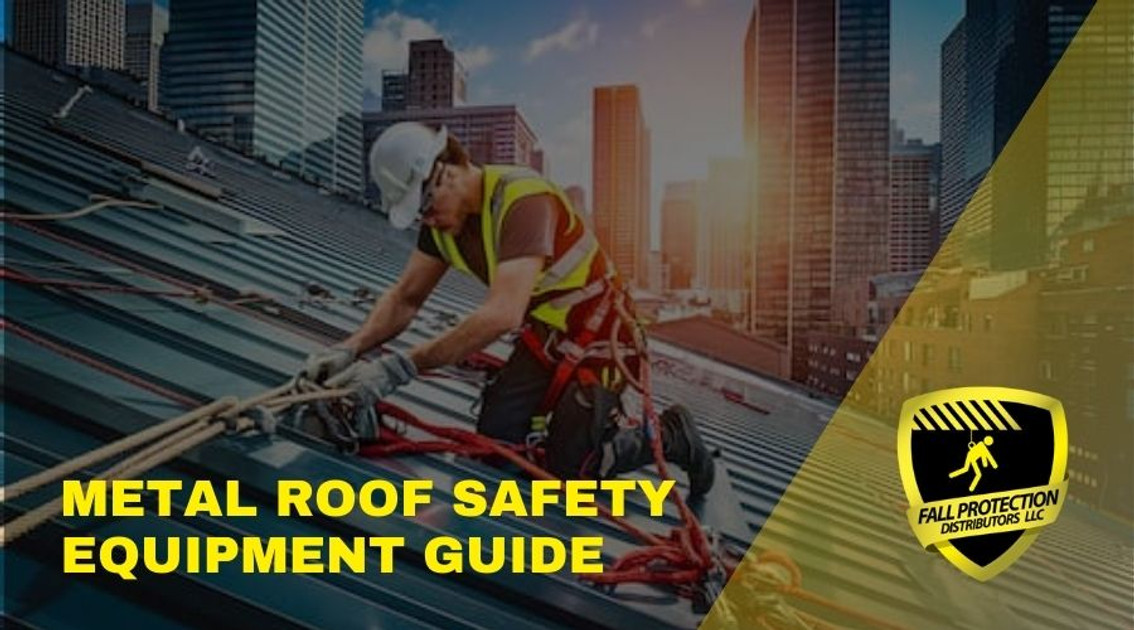Guide to Metal Roof Safety Equipment
Posted by Howie Scarboro - CEO Fall Protection Distributors, LLC on Mar 14th 2024
Metal Roof Safety Equipment
When it comes to working on metal roofs, safety should be a priority. Without the safety gear and secure anchors, the job can pose serious risks. Metal roofs, particularly standing seam style are known for having slippery surfaces that increase the chances of accidents. That's why having the correct metal roof safety equipment such as standing seam roof anchors and metal roof anchors is essential. In this guide, we will discuss all the important aspects of metal roof safety equipment.
The Significance of Metal Roof Safety Equipment
Metal roofing materials like steel, aluminum, copper and zinc can create slick surfaces, especially when they are wet. Without metal roof safety equipment in place, workers face a high risk of falls, injuries and even fatalities. Statistics from OSHA indicate that falls are a leading cause of fatalities in the construction industry with inadequate fall protection being a common violation.
This is why it’s crucial to invest in high quality metal roof safety gear and anchors that are specifically designed for use on metal roofs, including standing seam roofing systems. They can truly make a difference by saving lives and preventing severe injuries. The right equipment enables roofers to work at heights without worrying about slips or dangerous falls. There are two basic categories of metal roofs, standing seam and mechanically fastened metal roofs.
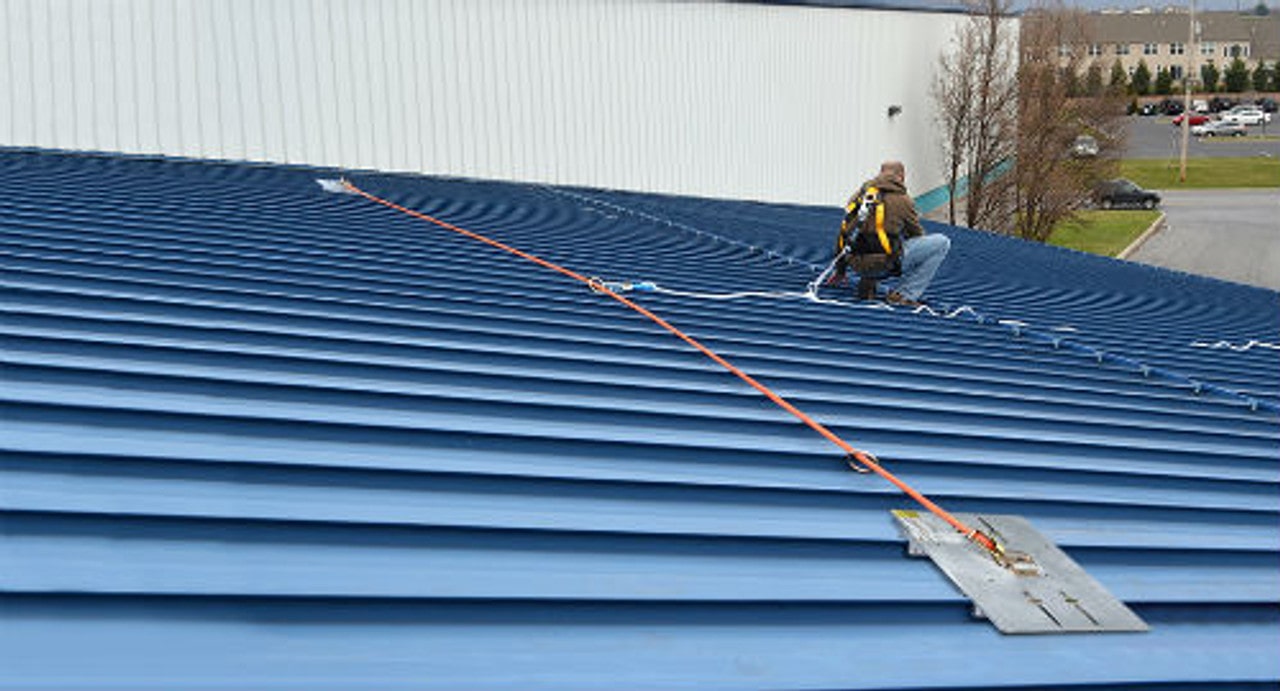
Fall Protection For Standing Seam Roofs
No penetrations are permitted on standing seam roofs in order to protect the roof from water leaks. Specially designed anchors for standing seam roofs utilize a series of set screws that lock onto the seam to provide the necessary anchoring strength. These anchors can be left in place permanently as they are incredibly strong and durable. They seamlessly integrate with safety equipment. When searching for standing seam roof anchors opt for models crafted from non-corrosive materials like aluminum that can endure harsh job sites and outdoor elements.
The Standing Seam Roof Anchor SSRA1 device uses 12 set screws to lock onto the seams with zero penetrations. Made of solid 6061 T-6 aluminum, the only moving parts are the bolts and set screws. The wide throat opening and thick structural body allows this one device to fit about 95% of today’s standing seam panel profiles. The Standing Seam Roof Anchor SSRA1 has the unique ability to allow workers to work at any angle around SSRA1 anchor point as it is tested in both shear and perpendicular impact directions. With the ability to accept adapter plates, the Standing Seam Roof Anchor SSRA1 becomes a complete component system assisting contractors in rigging safety systems for a variety of roofing situations that may require single anchor points, walkboards, or even horizontal lifelines without requiring any roof panel penetrations. Ultimate load tested to 14,500 lbs, it is proven to be the world’s strongest standing seam roof anchor.
Fall Protection For Mechanically Fastened Roofs
When dealing with mechanically fastened panels, there are far more options for attaching anchors. These types of roofing systems are designed to allow for penetrations. Examples of this type of roofing are commonly referred to as R-panels, PBR, Pro Panel and corrugated. Most anchors can be mounted to exposed fastener roofs as long as the fasteners are able to embed into solid structural material underneath the roofing panels.
Different types of metal roof anchors include ridge anchors hidden beneath the ridge cap, Ridge Pro anchors hook over the peak of the roof and can be mechanically fastened down to most types of roofing for a temporary anchor point. Horizontal lifelines are also permitted, as long as a 5,000 lbs anchor point can be established at each end of the rope.
Similar to standing seam anchors, choose metal roof anchors from brands made of sturdy non-corrosive materials like aluminum or stainless steel.
Ensuring proper installation subject to all instructions and safety regulations is paramount to ensuring the anchor’s performance in the event of a full impact fall.
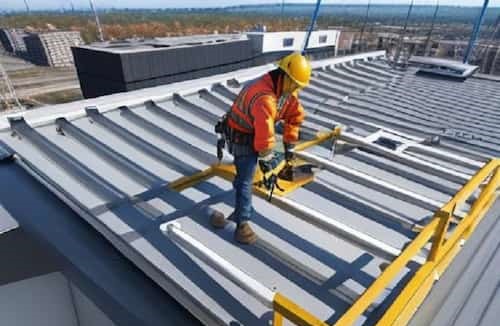
Bringing it All Together; Comprehensive Safety Solutions
The efficient approach to enhancing safety on metal roofs involves implementing a fully integrated solution using compatible components. This entails equipping your team with PFAS harnesses and shock absorbing lanyards, setting up a guardrail or netting system where feasible, and utilizing the anchors tailored to your specific roof type. Standing seam roof anchors for standing seam metal roofs and suitable mechanically fastened metal roof anchors otherwise.
Anchors need to be placed at intervals according to the manufacturer’s spacing guidelines to guarantee that a secure tie-off point is always accessible. Conducting hazard assessments, crafting site safety protocols, and offering comprehensive training are essential in ensuring that your workers are well versed in how to properly utilize their metal roof safety gear.
Metal Roof Safety Equipment Recap
There's no room for shortcuts when working at heights on slippery metal roofs. Having the metal roof safety equipment. Anchors, PFAS, guardrails, nets and more is absolutely essential in preventing serious injuries and saving lives. Prioritizing safety is crucial and investing in the metal roof safety equipment and anchors is a smart decision that enables your team to work with confidence and efficiency. Don't risk it. Ensure that your crews are equipped with the right metal roof anchors and safety gear for every project.
Rapid Fire Metal Roof Safety Equipment Q&A
What is the Ridge Pro system and how does it work?
The Ridge Pro is an innovative ridge anchor system designed to allow roofers to maintain 100% tie off at all times when working on steep roof pitches. It consists of a continuous anchor line that runs along the roof ridge, secured by base plates attached to the roof structure. Roofers can connect their personal fall arrest systems (PFAS) to this anchor line using a self-trailing roof anchor, allowing free movement while continuously tied off.
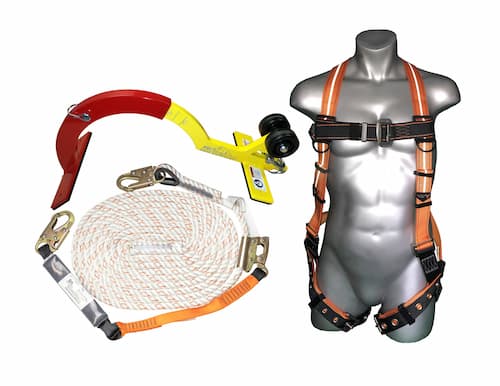
Why is 100% tie off so important when working on roofs?
Falls from heights are a leading cause of serious injuries and fatalities in the construction industry, especially roofing work. Maintaining 100% tie off by being continuously connected to an approved anchorage like the Ridge Pro system provides essential fall protection. If a fall occurs, the fall arrest system will catch the worker, preventing them from hitting the ground or any obstacles below.
What is the most important metal roof safety equipment to have?
The most crucial metal roof safety equipment is an anchoring system that allows you to tie off securely. For standing seam metal roofs, this means using specialized standing seam roof anchors that clamp right onto the vertical seams without penetrating the roof. For roofs without standing seams, you'll need metal roof anchors designed to attach with mechanical fasteners.
Having a secure anchorage point is essential for using personal fall arrest systems (PFAS) like harnesses and lanyards. Without proper anchors, these connecting devices have nothing to attach to safely. Anchors are the critical first piece for installing any other metal roof safety equipment.
How do standing seam roof anchors differ from regular metal roof anchors?
Standing seam roof anchors are specifically designed to secure to the raised vertical seams found on certain metal roofing systems like standing seam roofs. They typically use a clamping mechanism to grip onto the seam tightly without penetrating the roofing material itself.
Regular metal roof anchors, on the other hand, are meant for mechanically fastened panels without these raised seams. They may screw down, clamp on, or lock over the ridge or use other non-penetrating attachment methods.
The key with standing seam anchors is their specialized design that integrates seamlessly with the roofing profile. This allows them to provide incredibly secure, leak-proof tie-off points while being very easy to install and remove as needed.
What other metal roof safety equipment do I need beyond anchors?
While anchors are the critical starting point, there are several other key components that make up a complete metal roof safety system:
Personal fall arrest system (PFAS)
This includes a full-body harness that attaches to the anchor via a lanyard or lifeline to safely arrest a fall
Guardrail systems
Temporary railings can be installed along roof edges and anchored for additional fall prevention
Safety netting
Nets suspended below the roof can catch falling workers if arrested properly with anchors.
Accessories
Roof anchors, cable grabs, rope grabs, carabiners, and more components that integrate with the overall system
The anchors allow you to assemble a comprehensive metal roof safety setup with multiple layers of protection. OSHA often requires having fall prevention, fall restraint, and fall arrest systems in place for low, sloped, and high-pitched metal roofs. Using high-quality anchors and safety equipment together is key.
How do I choose the right standing seam roof anchor or metal roof anchor?
There are several important factors to consider:
Roof type & material –
Ensure you get anchors designed specifically for standing seam vs mechanically fastened metal roof systems.
Weight ratings
Anchors must be able to withstand required force loads per safety standards
Installation method
Some anchors clamp, others mechanically fasten; consider removal and permanence
Materials
Look for durable options like aluminum or stainless steel rather than plastic or coated steel options
Brand
Stick to reputable, trusted manufacturers for maximum safety and quality
Compatibility
Make sure anchors work seamlessly with the other safety gear you'll use
Code compliance
Check that any anchor meets all applicable local and national standards
Getting the right anchors and using them properly according to the manufacturer's instructions is absolutely critical. Don't cut corners - your life and your crew's lives depend on having safe, secure metal roof anchors.
How is the Ridge Pro installed on a roof?
The Ridge Pro ridge anchor system is installed at the roof ridge, with the base plates securely anchored to the roof structure using specialized fasteners or anchors made for the specific roof type. The vertical lifeline extends down the roof slope for the worker to attach to before stepping from the ladder to the roof surface.
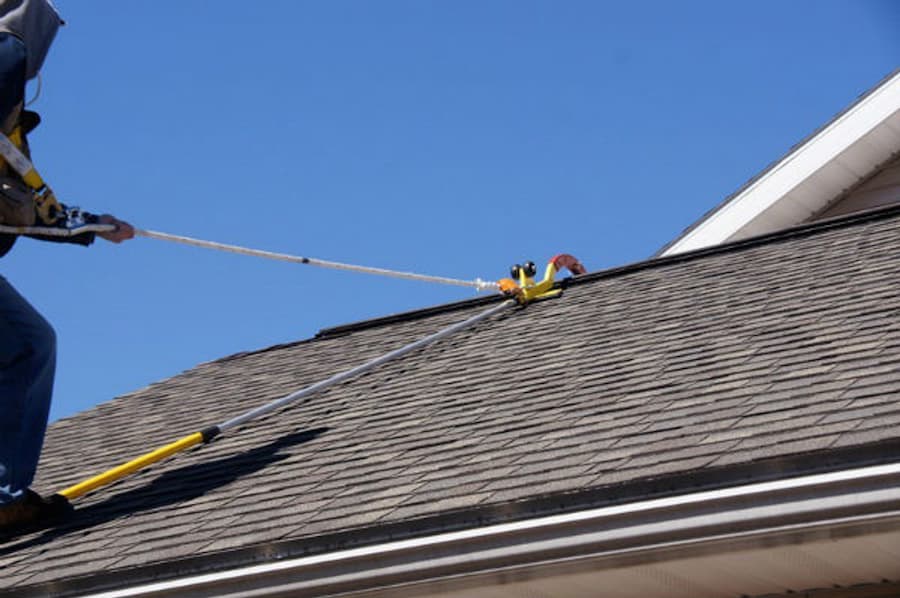
What are the main benefits of using the Ridge Pro system?
Some key benefits of the Ridge Pro steep assist system include continuous fall protection with no lapses in tie-off, increased efficiency by eliminating disconnecting/reconnecting, versatility for different roof types, compliance with OSHA regulations, and peace of mind knowing your team has maximum fall protection. It allows roofers to work confidently at heights.
Is special training required to use the Ridge Pro?
Yes, all personnel using the Ridge Pro or any other roof anchor system should receive comprehensive training from a qualified source. This covers proper installation, use, inspection, maintenance and overall safety procedures for the system. Lack of training can lead to improper use and increased fall risks.
How do I inspect and maintain the Ridge Pro system?
Before every use, thoroughly inspect all components of the Ridge Pro system - the anchor line, base plates, roof anchors, and your personal fall arrest system. Check for any damage, wear, corrosion or other defects. Follow all manufacturer guidelines for inspection, cleaning, storage and maintenance to ensure the system remains in safe working condition.
Can the Ridge Pro be used on all roof types and pitches?
The Ridge Pro ridge anchor is designed to be versatile for use on most common roof types and steep pitches 7/12 up to 12/12 found in residential and commercial roofing applications. However, you should always verify with the manufacturer regarding maximum/minimum roof slopes and any special requirements for your specific roof structure.
Where can I purchase the Ridge Pro system?
The Ridge Pro and related roofing safety products can be purchased at Fall Protection Distributors, LLC. The poles are ready available for around $40 at your local Home Depot’s paint department, look for the Wooster Sherlock R057 8’-16’ telescoping painter’s pole. We specialize in standing seam roof anchors, metal roof fall protection equipment, horizontal lifelines for metal roofs, and walkboards for standing seam roofs. Investing in quality safety gear like the Ridge Pro is essential for any professional roofing operation.

